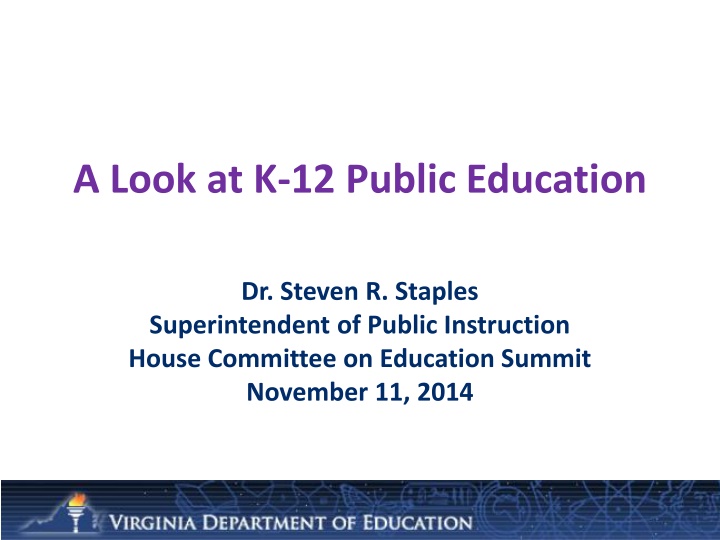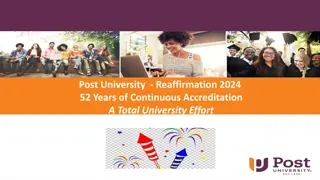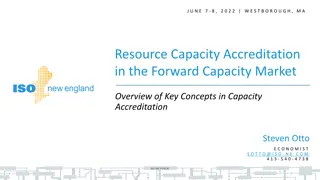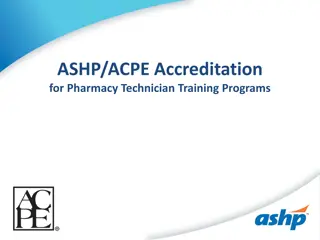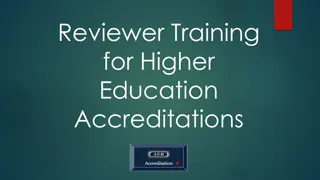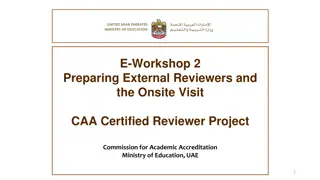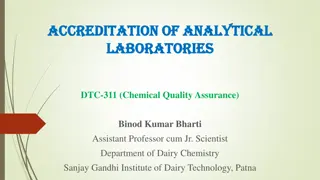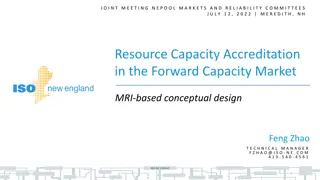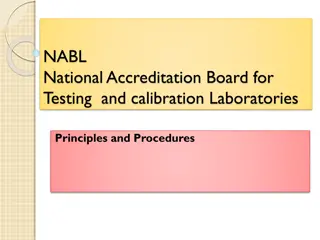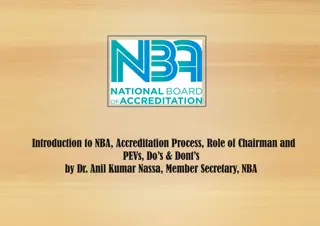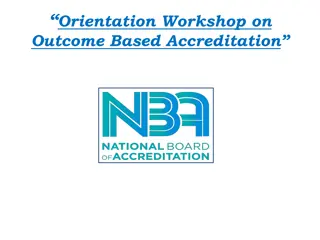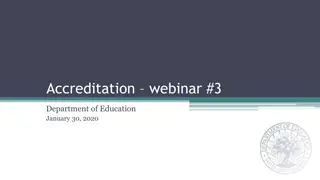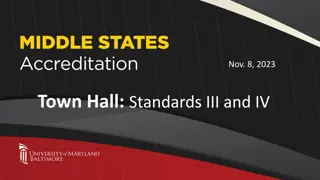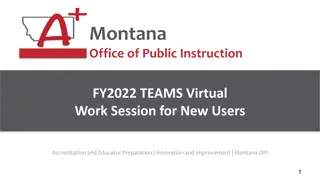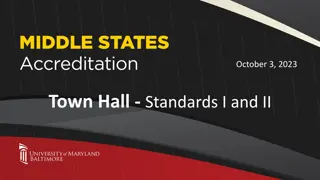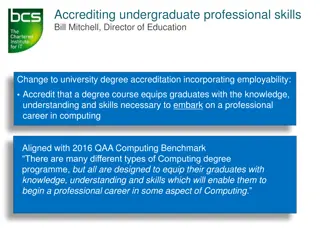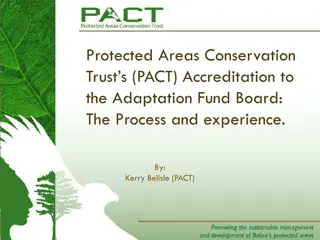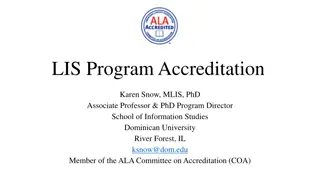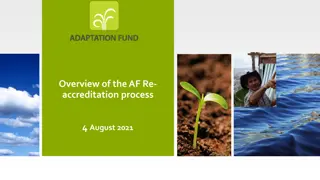Insights into K-12 Education Accreditation Process
The accreditation process for K-12 public schools, including compliance with standards, achievement of accountability requirements, and benchmarks for fully accredited ratings. Learn about the ratings awarded, requirements for full accreditation, and consequences for schools not meeting the benchmarks.
Download Presentation

Please find below an Image/Link to download the presentation.
The content on the website is provided AS IS for your information and personal use only. It may not be sold, licensed, or shared on other websites without obtaining consent from the author.If you encounter any issues during the download, it is possible that the publisher has removed the file from their server.
You are allowed to download the files provided on this website for personal or commercial use, subject to the condition that they are used lawfully. All files are the property of their respective owners.
The content on the website is provided AS IS for your information and personal use only. It may not be sold, licensed, or shared on other websites without obtaining consent from the author.
E N D
Presentation Transcript
A Look at K-12 Public Education Dr. Steven R. Staples Superintendent of Public Instruction House Committee on Education Summit November 11, 2014
Accreditation Process Annual accreditation based on: Compliance with pre-accreditation eligibility requirements of Standards of Accreditation (SOA), reported by principals and superintendents Achievement of school accountability requirements of SOA based on Standards of Learning (SOL) tests pass rates and, for high schools, benchmarks for graduation
Benchmarks for Fully Accredited Ratings Awarded in the 2013-2014, 2014-2015 and 2015-2016 School Years (Based on Testing and Graduation Rate Data from the 2012- 2013, 2013-2014 and 2014-2015 School Years) Subject Grade 3 Grade 4 English 75% 75% Mathematics 70% 70% Science History/Social Science Grade 5 75% 70% 70% Grades 6 to 12 75% 70% 70% 70% 70 percent at Grade 4 or 5 85 pts./82 pts.* 85 pts./83 pts.* 85 pts./84 pts.* 2013-2014 2014-2015 2015-2016 Graduation and Completion Index (for schools with a graduating class) *Benchmarks for Provisionally Accredited Graduation Rate. This rating will no longer be awarded after the 2015-2016 School Year.
Schools Not Fully Accredited 2002-2003 until 2014-2015 700 648 New Reading, Writing, and Science assessments; Board adopted new cut scores; Accreditation benchmarks increased for Grade 3 Science & History from 50% to 70%, & for Grade 6-12 English from 70% to 75% 600 567 500 400 401 400 New Mathematics assessments; Board adopted new cut scores All divisions administered US History to 1877, US:1877-Present, & Civics/ Economics assessments 300 261 New History/Social Science assessments; Board of Ed. adopted new cut scores 200 144 136 111 To meet NCLB requirements for Reading & Mathematics: assessments added for Grades 4, 6 & 7; Grades 5 & 8 no longer cumulative 133 71 62 100 Last administration of Grade 8 cumulative History assessment 25 19 0 2002-03 2003-04 2004-05 2005-06 2006-07 2007-08 2008-09 2009-10 2010-11 2011-12 2012-13 2013-14 2014-15 5
School Accreditation Ratings Fully Accredited: Meets all benchmarks for achievement levels Accredited with Warning: Adjusted pass rates for a core subject(s) is below benchmark or failed to meet minimum threshold for graduation and completion index Accreditation Denied: Failed to meet the requirements for full accreditation for four consecutive years Conditionally Accredited: New school or reconstituted school (awarded to a school that fails to meet full accreditation requirements for four consecutive years and receives permission from the Board of Education to reconstitute)
Accreditation 2014 Sixty-eight percent, or 1,246, of Virginia s 1,827 public schools are rated as Fully Accredited for 2014-2015, compared with 77 percent for 2013-2014, and 93 percent for 2012-2013. The number of schools Accredited with Warning rose to 541, an increase from last year s total of 393. The drop in accreditation came despite statewide improvements in mathematics performance and hundreds of schools that also saw incremental gains in reading, writing and science. Thirteen schools in six divisions are denied state accreditation for 2014-2015 because of persistently low student achievement.
2014-2015 Accreditation Ratings Number of Schools Percent of All Schools Accreditation Rating Fully Accredited 1,249 68% Accredited with Warning 541 30% Accreditation Denied 13 <1% Provisionally Accredited 2 <1% Conditionally Accredited (New Schools) 10 <1% Conditionally Accredited (Reconstituted Schools) 11 <1% To Be Determined 0 0% Total Schools 1,826 100%
Federal and State Accountability Systems Support and interventions from VDOE under the federal Elementary and Secondary Education Act (No Child Left Behind) is focused on Virginia s lower and lowest-performing Title I schools, including those missing annual measureable objectives (AMOs) for narrowing achievement gaps. Support and interventions to schools not fully accredited under the state accountability system are graduated depending upon the number of years of failure to achieve full accreditation, including years of Accreditation with Warning status.
Actions Prior to Denied Status 1. Academic review by an external team, with focus on curriculum alignment and engagement of school division leadership in process 2. Development and monitoring of a school improvement plan 3. Assignment of external contractor to school to guide actions and support building level efforts 4. Ongoing technical assistance and professional development in instruction and assessment 5. Monthly monitoring by VDOE Office of School Improvement and external contractor
Some Success As a result of testing results in 2013-14, 74 schools exited Accreditation with Warning status in 2014-2015.
Conditionally Accredited Schools A rating of Conditional Accreditation may be granted by the Board of Education to schools that would otherwise be denied accreditation. The school divisions must agree to reconstituting the school s governance, its instructional program, its staff, or the student population. For 2014-2015, the superintendents of all schools granted a rating of conditional accreditation must enter into a collaboratively developed Conditional Accreditation Agreement with the Superintendent of Public Instruction. The agreement outlines Essential Actions that must be completed based on specific needs of the school.
13 Schools Denied Accreditation for 2014-15 As required by the Standards of Accreditation, the Virginia Board of Education and local school board enter into a Memorandum of Understanding (MOU) based on the needs of the school. For 2014-2015, prior to the development of each MOU, OSI staff met with the superintendent of each denied schools to identify areas in which the school needed support. Using this information, the MOUs were customized for each school. A corrective action plan that specifies the actions that must be taken to improve the performance of the school is developed based on the MOU. Quarterly meetings are held to discuss progress in addressing the essential actions included in the corrective action plan.
Next Steps Focus on attracting and retaining quality teachers in struggling schools Continued focus on improving quality of instruction in classroom and the capacity of principals to provide helpful feedback to teachers Emphasis on providing wrap around services for students
Challenges and Obstacles to a Focus on School Improvement
Virginia General Assembly Mandates for Board of Education, VDOE, and School Divisions 2011-2014 Year 2011 2012 2013 2014 VDOE/BOESchool Divisions 3 16 15 13 11 9 18 16 Total 47 54
Educational Challenges Overall, student enrollment has increased by 2.5 percent statewide since 2008. In the last five years: the number of economically disadvantaged students has grown from 34 to 41 percent of Virginia s public school students. English Language Learners in Virginia have grown to 95,000, an increase of 15 percent. The percentage of students with the most need for intensive special education, such as autism and other health impairments, has grown by 23 percent to 46,865.
Educational Challenges continued Gaps between economically disadvantaged students and peers have grown as much as 35 percentile points on NAEP reading and mathematics scores. Subgroups of students, such as Economically Disadvantaged, English Language Learners, and Special Education, require more intensive interventions and more resources to teach.
Educational Challenges continued In FY 2014, General Fund Direct Aid to Public Education is $308,616,613 less than it was in FY 2007. Since 2008, K-12 public education staffing has been reduced by 5,000 positions in Virginia. The top critical shortage area among endorsed teachers is Special Education.
VDOE Staffing Total VDOE Filled Fulltime Positions 350 300 250 200 Series 1 150 100 50 0 1-Jan-08 1-Jan-09 1-Jan-10 1-Jan-11 1-Jan-12 1-Jan-13 1-Jan-14
Despite these obstacles and challenges, Virginia Fares Well Student Achievement: Virginia & the Nation
Virginia & NAEP Percent Proficient or Above Grade-4 Reading
Virginia & NAEP Percent Proficient or Above Grade-4 Mathematics
Virginia & NAEP Percent Proficient or Above Grade-4 Science
SAT: Mathematics Mean Scaled Scores
SAT: Reading Mean Scaled Scores
SAT: Writing Mean Scaled Scores
ACT (College Readiness Benchmarks): Mathematics
ACT: Reading
ACT: Grammar & Usage
ACT: Science
ACT: Composite
Advanced Placement 2013 Graduates with Qualifying Scores
2013 NAEP-TIMSS Linking Study Mathematics
2013 NAEP-TIMSS Linking Study Science
SOL Innovations Committee Created in 2014 legislative session through HB 930 and SB 306 and signed by the Governor on April 4, 2014 Established by Secretary of Education, staffed by VDOE Examining next steps for accountability reform that maintains positive gains of current system but responds to changing needs
In 1995 The cost of a gallon of gas is $1.09 per gallon. Microsoft releases Windows 95 and the first version of Internet Explorer. 18 million American homes are online, but only 3 percent of online users have ever signed on to the World Wide Web. The iPhone is not yet invented. The SOL and Accountability Reform System begins in Virginia.
Consideration and Opportunities for Accountability 2.0 How can the next phase: drive improvement as well as identification? account for moving toward , meeting and exceeding standards? identify areas in which schools are struggling? drive equity for schools with high percentages of children in poverty? What is the appropriate failure point for consequences? What is the appropriate pace of changes to the standards & tests? What is the course of action if Virginia reforms do not align with federal accountability?
Expansion of Learning Opportunities: Virtual Virginia 40
Mission Program of the Virginia Department of Education serving students in middle and high schools Offers equitable access to online courses for students who might not be able to take Advanced Placement, world language, core academic, and elective courses due to the lack of a highly-qualified instructor, too few students to offer the course, or scheduling conflicts within the school
Courses and Curriculum Aligned to Virginia s Standards of Learning Authorized by the College Board Includes readings, discussion forums, written assignments, media, student presentations and projects, case studies, simulations, virtual lab assignments, models, interactive assignments, and opportunities for collaboration Currently offers 54 courses
Technical Infrastructure Web-based learning management system (BrightSpace) Communication hardware and software Technical support for schools, including helpdesk
Instruction Synchronous and asynchronous Available 24/7 Teachers are facilitators, learning managers, and tutors
Teachers 66 Highly-qualified teachers Licensed in Virginia Endorsed in subject area Trained in providing online instruction Average student-teacher ratio is 109:1
Who Uses VVA Courses? Virginia Public School Students (10,097) Virginia Private School Students (41) Virginia Home-schooled Students (9) Out-of-State Students (43)
Advanced Placement Courses Chinese Environmental Science European History French Language & Composition Government and Politics: Comparative Macroeconomics Art History Biology Calculus AB Calculus BC Computer Science A English Language & Composition English Literature & Composition Government and Politics: U.S. Human Geography Latin Literature Physics B Psychology Spanish Language Statistics U.S. History World History Microeconomics
Standard Courses Arabic I Arabic II Arabic III Astronomy Chemistry Chinese I Chinese I Chinese III Chinese IV Creative Writing Earth Science I Earth Science II: Astronomy Economics & Personal Finance Intro to Game Design & Development Latin I Latin II Latin III Latin IV Physics (Honors) Pre-Calculus & Math Analysis IntroductorySpanish Beginning Spanish Intermediate Spanish Advanced Spanish Survey of World Languages & Cultures World History I World Mythology
Fiscal Year 2013-2014 DOE? $4,283,807 Allocated *Cost per student served $421 Administra on? 5%? Curriculum? 12%? Support? Services? 15%? Instruc on? 68%?
